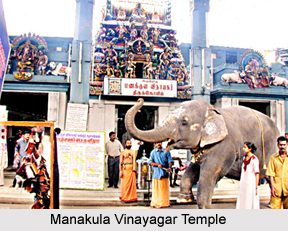 Manakula Vinayagar Temple, located in Puducherry, is one of the famous ancient temples. It is located in the southern part of Indian sub-continent. The temple is 400 meters West of Bay of Bengal, 165 Km South of Chennai, 23 Km of North of Cuddalore and 35 Km East of Villupuram, in the Indian state of Tamil Nadu. The main deity "Sri Manakula Vinayagar" (Pranavamurthy) of this temple is facing east and the temple is bordered on east by Orlean Street. Prior to the rule of French, the area of the temple was known as weaver`s street and was renamed as Orlean Street by them. This particular place was a part of the town where French and white people lived. They made all possible effort to remove the deity from this place and even went to the extent of throwing the deity in the sea and every time he came back to the same place, where the temple is now. Later the temple was built near the Bay of Bengal shores as per the Ganapathy Agamam and was named Bhuvanesa Vinayagar Temple.
Manakula Vinayagar Temple, located in Puducherry, is one of the famous ancient temples. It is located in the southern part of Indian sub-continent. The temple is 400 meters West of Bay of Bengal, 165 Km South of Chennai, 23 Km of North of Cuddalore and 35 Km East of Villupuram, in the Indian state of Tamil Nadu. The main deity "Sri Manakula Vinayagar" (Pranavamurthy) of this temple is facing east and the temple is bordered on east by Orlean Street. Prior to the rule of French, the area of the temple was known as weaver`s street and was renamed as Orlean Street by them. This particular place was a part of the town where French and white people lived. They made all possible effort to remove the deity from this place and even went to the extent of throwing the deity in the sea and every time he came back to the same place, where the temple is now. Later the temple was built near the Bay of Bengal shores as per the Ganapathy Agamam and was named Bhuvanesa Vinayagar Temple.
History of Manakula Vinayagar Koil
This temple is called as Manakula Vinyagar, as that time there was pond (Kulam in Tamil) on the western side of this temple and due to proximity of Sea, pond was full of sand (Manal in Tamil), hence it was called as "Manakulam". Currently the temple is constructed in 7913 square feet with outer Mandapam, Raja Gopuram, Kodikambam (18ft tall gold plated), front Mandap, Mahamandap, Sanctum, walk around area, other deity Prahara, kitchen, office, Urcharvar deity, Marriage Hall, Inside the temple, the presiding deity placed in Karuvarai area 4 X 4 square place as the sanctum and the Vimanam above covered fully with gold plated.
Architecture of Manakula Vinayagar Koil
Golden Kavasam
Above the Moolavar deity (sanctum), the existing Vimana was fully covered with golden plate by using 10 Kg gold, which was made on the basis of donations from the devotees.
Golden Vimanam
The golden chariot was made purely on the basis of collection of donations from the devotees. The total weight of the gold used in this chariot is 7.5kg with the estimate of around Rs.35 lakhs. The height and breadth of the chariot is 10ft and 6ft respectively. The chariot was fully made up in teakwood covered by copper plates duly engraved with beautiful art works and the plates duly attached with golden rakes.
Inside the temple the southern side Pragaram wall three rows of god sculptures and stone engravings are placed. In top row 33 different types of Vinayagar idols and in second row 25 types of Vinayaga idols and in the third row stone engravings of Vinayagar Kavasam, Bharathiyar`s Vinayagar Nanmanimalai, Ashtalakshmi Sthothiram, Idumban and Kadamban Kavasam and Sri Vinayagar Asthothiram were found.
In the front Mandap vithanam and inside historical scenes have been painted taking the services of renowned painters. Some of them are Birth of Lord Vinayagar, killing of Kayamuga Sura, Vinayagar marrying Suddhi and Buddhi, Vinayagar blessing Nambiyandar Nambi, etc.











